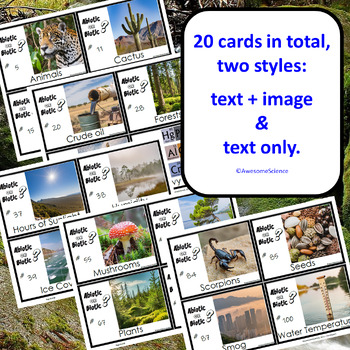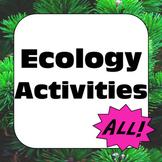Abiotic & Biotic Factors Card Sort for Living & Non-Living Things in Ecosystems
- PDF
- Easel Activity
- Easel Assessment
What educators are saying
Also included in
- A bundle of activities for Ecology, Environmental Studies, and Earth Science.Please see individual files for additional details.Click here to follow my store and receive the latest updates.Original Artwork (©AwesomeScience). For Personal Use Only. Uneditable.Page count does not include Terms of UsePrice $39.00Original Price $43.33Save $4.33
Description
An abiotic & biotic card sort activity containing 102 living & non-living components of an ecosystem! Great hands-on activity for your ecology/ecosystem unit.
Will there be terms your students don't know?
Thankfully YES!
This resource will not limit discovery and will encourage curiosity.
All in the name of learning and vocabulary building!
The entire class may collectively participate in sorting the wide variety of factors contained in this resource. Laminate, add some magnets, and sorting may take place on the whiteboard.
- 1-page teacher notes.
- 2-pages abiotic & biotic placemats.
- 34-pages abiotic & biotic factors to sort. (3 per page, landscape, large size.)
- 2-pages answers.
- 2-pages blank templates (for additional factors).
- 5-Easel activities.
Each contains 2-slides with 10-factors to sort on each slide.
Terms are strategically placed so the least specialized terms are found in Easel activity #1
(i.e. fish, wind, sand, bees).
Terms become more specialized as students progress through to Easel activity #5
(i.e. turbidity, salinity).
Auto-grading & students may self-check their understanding using this tool.
These are great for formative assessment.
- 10-Easel assessments.
Each contains 10-factors to sort.
Terms are mixed together.
Auto-grading & students may self-check their understanding using this tool.
These are great for summative assessment.
This activity is designed to allow for the option of optical mark recognition (OMR) grading methods.
Click here to follow my store and receive the latest updates.
Original Artwork (©AwesomeScience). For Personal Use Only. Uneditable.
Page count does not include Terms of Use and links to supplementary activities.
Copyright ©AwesomeScience 2016 – The Present.
All Rights Reserved by Author.
By using this Resource you agree to the Terms as outlined in the Terms of Service. This Resource is for limited Personal Use only; not to be used, in part or in whole, for commercial purposes. Each Individual License is for use by one specific educator only. Additional licenses must be purchased for each additional educator. Except as permitted in Section 3 to deliver Resources electronically to Permitted Recipients, you may not post or otherwise make the Resource available on any website, application, shared drive or other sites or services.







